
Kira & I (photo by my sister Lis)
If anything, they're less clear. Kira told me on Thursday when I skipped dinner that I "smelled like roti"--we hadn't told her we'd snuck off to India Palace to celebrate a friend's successful thesis defense, but she knew. Kira says that the bhangra CD she loves to dance to is "part of India," as are the kurta pajama I wear sometimes and a few of the evening stories I tell. She is probably aware that India is also a physical place, something like Florida where she knows she spent her earliest childhood and where some relatives live...but I don't think that she thinks the place is what India is. India is some mix of all these elements, some groups of people and things, that she is aware I am somehow inexorably connected with. I am part of India, she has decided, and somewhere in her mind I think she's still mapping out the rest.
Adults ask their questions for different reasons and with different emphases. They see my face and want an explanation as to why I look different than they do. For many, there's still a sense that face and place still must be closely connected (after all, they do rhyme), which simplifies questions but complicates the answers. Where can I possibly say that I'm from that will explain what they want to know? They're hoping for an answer about the world that will explain me, as opposed to finding things out about me that help give them access to new corners of the world. Kira, still relatively new to the world, is willing to work a little bit both ways, but seems to give preference to the latter.
I've wondered, for years, whether we should teach most of history this way. Instead of starting with the big events that affected everyone, why not start with some people's stories and go on to show which events and identities they were part of?
Maybe the intersections people embody would shed more light on history than the categories we would love to create.

Beautiful. (It's like autoethnography.)
ReplyDeleteSo beautiful. And I know that my daughter Josie, even though she doesn't share your ethnicity, feels like SHE is "part of India" because she loves it so much!
ReplyDeleteAnd I think your idea for teaching history rocks. Maybe then we would actually teach the truth...what is that line from WICKED...back where I come from we tell lies all the time: we call it history. Something like that. I think individual experiences are probably more true.